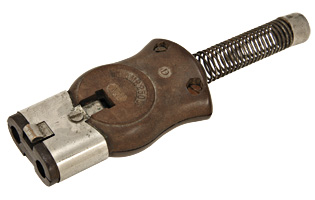 |
Albert Büttner's patent on earthed plug - socket system |
Schuko |
| ABL
/ Albert
Büttner
DRP* No. 489003 and
Siemens-Schuckertwerke /
Wilhelm
Klement DRP No. 567906 (1930) are regarded as respectively the first and
final patent of a
plug-socket system that is better known as the Schuko system. The Siemens patent is shown on the Origin of Schuko page. Find below details of Albert Büttner's patent. Figures from the patent applications may help to understand the efforts that have been made to develop safe earthed plugs and sockets that complies with KPI 1928 (see Origin of Schuko). Full patent text is available on DEPATISnet. To find the 1926 ABL patent the following steps have to be taken: • click DEPATISnet to open the Einsteigerrechche form. • type DE000000489003A in field Veröffentlichungsmummer (prefix DE000000 and suffix A are essential; • delete A47J31/24 in field Alle IPC Felder ! • click Recherche starten button; • in Trefferliste click PDF button below Original-document; • patent appears in new window; to facilitate scrolling through the Patentschrift click grey Volldokument laden button. * DRP stands for Deutsches Reichspatentamt (German State Patent Office), operational from 1877 until 1945. |
| DRP No. 489003 - Bayerische Elektrozubehör
A.G. in Lauf, Pegnitz (Albert Büttner); valid from Jan. 22, 1926 Title: Stecker mit Erdungseinrichtung (Plug with Earth connection) |
| Figures of the patent are very
detailed. Colours have been added to facilitate understanding of
crucial
elements. Green: parts directly related to earthing. Yellow: earth wires. Red: system components. Figures (Abb.) 2 and 5 are identical to figs 1 and 4, but seen from a 90º rotated viewing point. Fig. 3 shows a plan of the socket base. a: cord with three wires (L, N, E); b: wall plug; c: appliance connector plug; d: socket; e: appliance inlet; f: metal housing of appliance. Both plugs (b,c) have a metal cast (2). Bolds 14 connect the cast with the earth wire 13. Nos. 14a and 14b are nuts. The rim of casts are folded to form a flexible bulge (15). Recessed socket (d) has a metal strip (18) that is folded along the inside of the cavity (16). Strip 18 is positioned perpendicular to the imaginary line that connects L and N pins (compare Abb. 1 and 2). The strip is connected to the earth wire of a flex or network cable (24) via bold 26, metal strip 22 and bold 23. When wall plug b is inserted into socket d, contact between bulge 15 and strip 18 is made first. Therefore it is essential that the socket has a recess (16). Appliance inlet (e) has a metal cast (30) that is in direct contact with metal parts of the appliance housing f (for example an iron). Inlet pins 28 are sunk below the top of cast 30. This is according to DIN VDE 4990 (see image below). When connecting the appliance connector plug c to inlet e, earth contact is made first between bulge 15 and inlet cast 30. Making earth contact first is a prominent safety feature of the Albert Büttner's patent. Source
of DE489003A Abb.1-5:
Deutsches Patent- und Markenamt, Deutsches Patentinformationssystem. Note: original figs do not have colours. |
 |
| Left: electric iron made by Olymp. Note the appliance inlet according to DIN VDE 4990 standard. Right: appliance connector plug made by ABL. Although not being the original model it has the essential characteristics as described in the ABL patent. The shown model has a smaller metal case. Earth contact is made by a strip connected to the case. Wall plugs similar to patent model b must have existed. They were shown at an exhibition in Leipzig in 1925, but it is unclear whether any still exist. |
 |
 |
| |
D i g i t a l M u s e u m o f | |
P l u g s a n d S o c k e t s | |